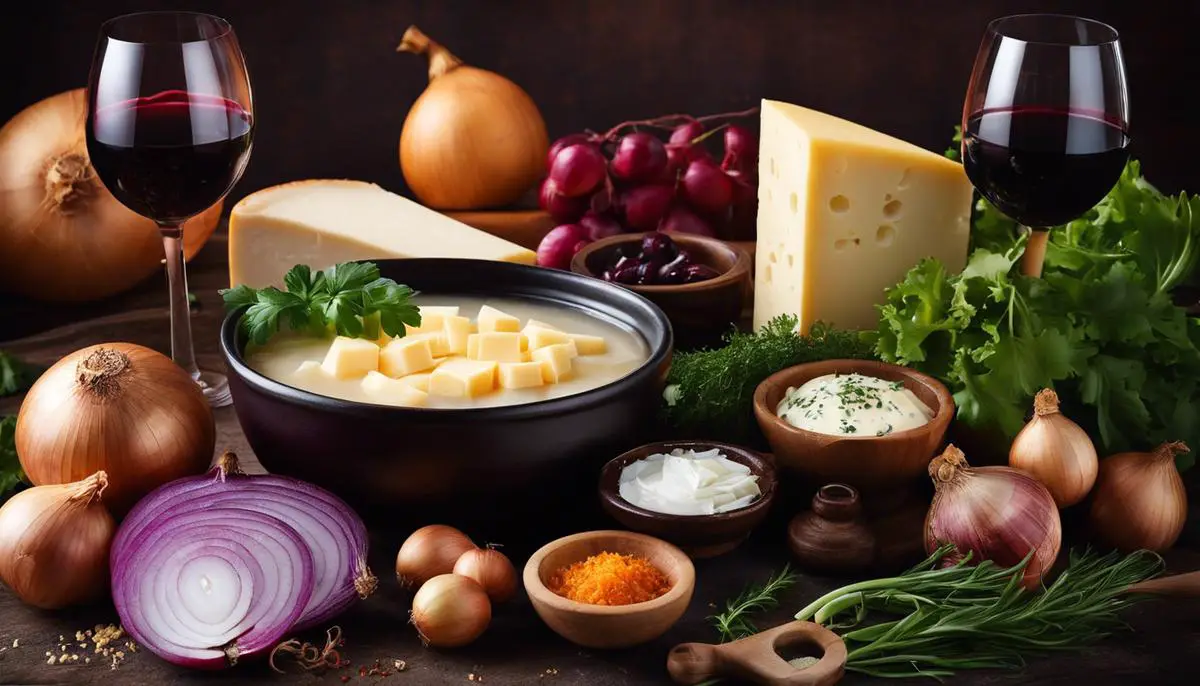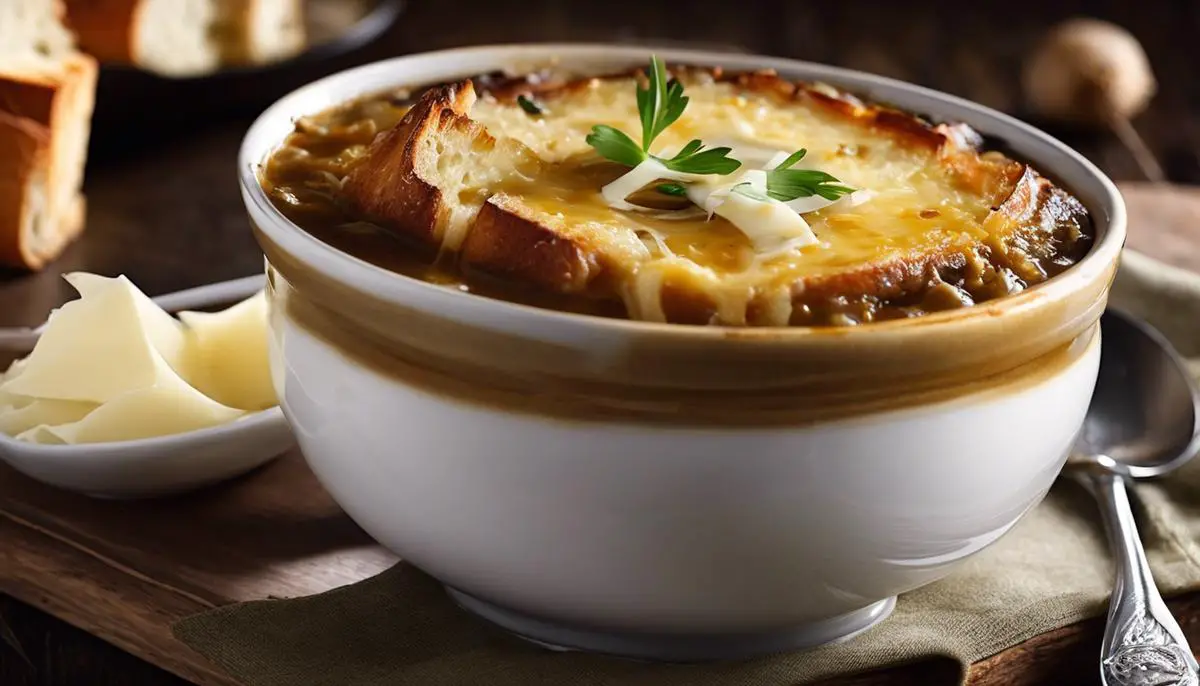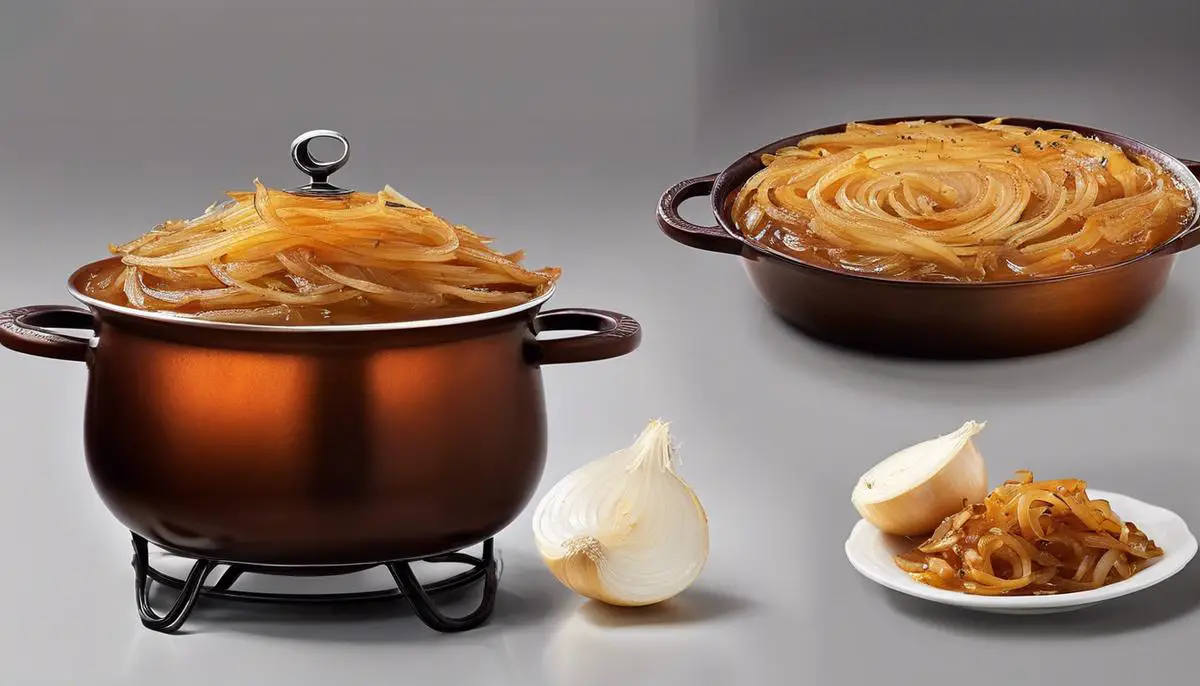
Rich in flavor, warming, and comfortingly savory, the French onion soup is a timeless classic loved across the globe for its delectable blend of caramelized onions, flavorful broth, and a cheesy, crusty top. Unlocking the secrets to perfecting this cherished recipe doesn’t have to be a daunting task. The fundamental aspect lies in selecting the right ingredients that include the right onions, the kind of cheese and wine to use, and the perfect broth. Preparing and Cooking the onions in the right manner, especially caramelizing them, brings out an irresistible flavor that is the very soul of this soup. Lastly, assembling and baking the soup in the most suitable way can lend it its quintessential, cheesy-crusty texture and flavor.
Selecting the Right Ingredients
When one thinks of heartwarming, soul-comforting food, the image of a bowl of French onion soup often comes to mind. This favorite dish hails from France but has captured the hearts of food enthusiasts around the world. Known for its caramelized onions, rich broth, and melty cheese topping, it is fairly simple to prepare if you understand the importance of sourcing and selecting the correct key ingredients. So, come along, dear reader, and let’s break down the need-to-know details for creating that perfect serving of French onion soup.
Firstly, let’s talk about the star of the show – the onions. Ideally, yellow or sweet onions are your go-to, known for their perfect balance of sweet and savory. When caramelized, they ooze a comforting sugary flavor. Opt for firm, plump, and shiny specimens that feel heavy for their size.
Next up is the broth. The choice between using beef, vegetable, or chicken broth can significantly influence the final taste. An excellent dark beef broth will lend a robust, meaty depth to your soup, which is traditionally favored. However, don’t shy away from a good vegetable broth if pursuing a vegetarian version. In either case, homemade broths are always the winners, but if needed, store-bought ones can also do the job.
Another critical ingredient is the wine used for deglazing – a vital step that lifts caramelized bits from the pan and introduces them back into the soup, enriching its flavor. A dry white wine, such as Sauvignon Blanc or Pinot Grigio, works wonders by contributing a crisp acidity that complements the sweet caramelized onions.
The herbs and spices can make or break your rendition of a French onion soup. Good quality dried thyme and a bay leaf suffice, but using fresh thyme sprigs can lend a lovely brightness.
Finally, the crowning glory of this dish, cheese and bread. A crusty baguette sliced thin and toasted till golden, forms the perfect base to capture the soup, while the cheese lends a creamy heartiness. Traditionally, Gruyere cheese is the champion with its excellent melting properties and slightly nutty flavor. However, besides Gruyère, Comte or even Emmental can work. It’s crucial to use a good quality cheese that renders a rich, creamy broth instead of an oily one.
Those are the key ingredients in a French onion soup done right. Happy cooking! Remember, the dish is as much about the process as the end result – it’s a labor of love, a joyous journey of combining simple, carefully chosen ingredients to create a melody of flavors. It’s a celebration of friendship, unity, and the magic that happens when food is shared with love.

Preparing and Cooking the Onions
Preparing and Cooking Onions: The Heart and Soul of French Onion Soup
After hand selecting our perfect onions and procuring our high-quality beef broth, the very lifeblood of our stellar French onion soup, it’s time to delve into the art of actually preparing those onions for the simmering pot.
The magic of transforming an everyday onion into something spectacular lies greatly in the method of preparation. Your dream soup deserves passion, patience, and precision on every level – especially when it comes to the dish’s star ingredient.
Step one: you’ve got to consider your choice of tools. What you’re looking for here is a sturdy, razor-sharp chef’s knife. A dull blade could reduce your slicing experience to pointless tears – quite literally. The sharp knife you opt for can not only make your slicing experience seamless, but it can also minimize the release of the onion’s tear-inducing gases.
Onion slicing is an art form in itself and calls for special attention. As food enthusiasts, we highly recommend slicing the onions into medium-thick pieces. Too thin, and they disappear as they cook; too thick, and the soup’s texture becomes uninviting. Look for uniformly cut slices to maintain consistency and achieve the dish’s desired caramel-y effect.
Now, here’s where it gets interesting: it’s time to caramelize. This isn’t a race. Head the popular saying, “low and slow.” This method is all about the induction of sugars within the onions to produce its characteristic sweet and earthy tones.
Begin by melting a generous knob of butter in your pot, a nod to the authentic French proceedings. Once it bubbles, put in your sliced onions, reducing the heat to medium-low. Season with salt; this not only sharpens the flavor but also helps extract water from the onions, speeding up the caramelization process.
Rotate your onions every five or so minutes for about half an hour until you achieve a deep, rich color and intoxicating aroma. It’s this meticulous cooking process that gifts the soup its characteristic immersive flavor. The slow saute time ensures the onion sugars are delightfully caramelized without scorching.
Don’t rush this step. Embrace the slow food movement philosophy – slow down, put some love and care into your cooking, and savor this mindful moment in the kitchen. Trust us, the end product is worth it!
When onions are caramelized, for an extra depth of flavor, a dash of sugar or a sprinkle of baking soda can also be added. These help with further caramelization without making your soup overly sweet.
Every artful whisk, every thoughtful stir, every intentional move you make in the kitchen is what sets this masterpiece French onion soup apart from any ordinary onion soup. So remember, when it comes to the onions, pay attention to those finer details, and your diners will undoubtedly taste the difference.
So, the next time you’re in your kitchen, poised and ready to transform into a culinary wizard, remember these instructions. This is not just about making a classic French onion soup – it’s about practicing a craft, sharing the result, and, above all, reveling in the joy that your cooking brings. Bon Appétit!

Assembling and Baking the Soup
Now that all elements for our French onion soup are beautifully prepared and the mouthwatering aroma has filled your kitchen, it’s time to focus on assembling and baking. This part is crucial. It’s the culmination of the love, care, and time you’ve poured into the creation of this classic gastronomic delight.
Firstly, have your oven-ready crocks or bowls lined up, because it’s time to bring it all together. This is a beautiful form of culinary art, creating layer upon layer of flavors that build up to that first soul-warming spoonful. Ensure that your bowls are broiler-safe as they will need to endure high, direct heat.
Place your crocks on a baking sheet. This makes it easier to transport them in and out of the hot oven, and it catches any overflowing cheese that would otherwise have your oven smoking. Start by spooning enough caramelized onions and delicious broth into the crock to fill them halfway. Now, you’ve got a lovely broth soaking into the onions, spreading the flavor evenly and creating that melting pot of French deliciousness.
Find those hearty pieces of bread you have toasted earlier, and place one in each bowl. You want these to be substantial as their task is to support a glorious layer of melted cheese. Push the bread down a bit, not too much, just enough for it to soak up some of that heavenly broth below.
Now comes the crowning glory: the cheese. And while any cheese has its charm, a high-quality Swiss or Gruyere cheese takes your French onion soup to the next level. Grate this generously over the bread, making sure to spread it evenly so that it hugs every edge of your crock. A good tip is to let some of it hang over the sides; this will give your soup the classic look of melted cheese dripping down the sides – truly a sight for sore eyes.
Finally, comes the baking. Preheat your oven’s broiler. Once it’s hot, carefully place your baking sheet in the oven. Now, stand watch. Timing is everything to achieve that perfect, bubbly golden-brown surface. This usually takes between 2 to 4 minutes, but remember, every broiler is different so stay attentive.
Voila! You have skilfully assembled and baked a French Onion soup. Observe the golden hues of the cheese, the sensational aroma, the perfect blend of sweet onions and broth seeping up into the cheese and bread. This is not just a bowl of soup, it’s a culinary masterpiece, a testament to the joys of spending time in the kitchen, and an ode to shared meals.
As you serve, bear in mind that the first bite must be handled with care, as only then can the blend be truly appreciated. The cheese will be beautifully gooey, the bread just the right side of soggy, and the rich flavors of the caramelized onions and broth will blend to create a symphony in your mouth, a chorus of taste that epitomizes the joy of cooking.

Throughout your French onion soup-making journey, you’ll discover that it’s truly in the details where the flavor lies. By honing the art of caramelizing onions to perfection, meticulously selecting your ingredients, and mastering the baking process for the ideal crunchy crust and melty cheese, you enter a whole world of culinary satisfaction. So, roll up those sleeves and lose yourself in creating a bowl of French onion soup that not only warms the tummy, but also, comforts the soul. Bon Appétit!



